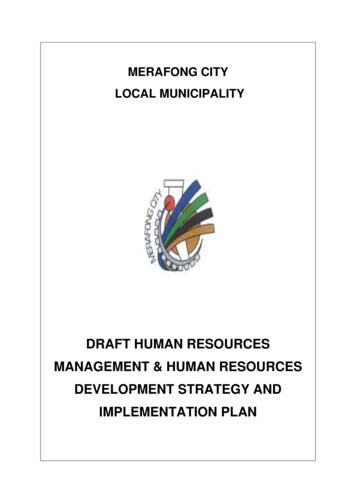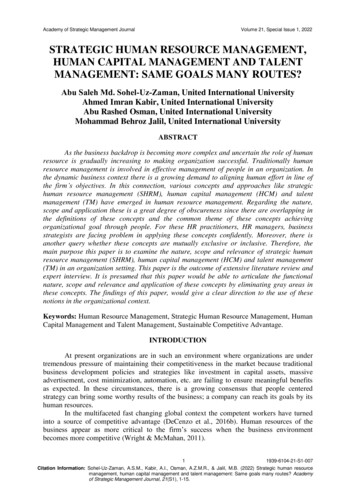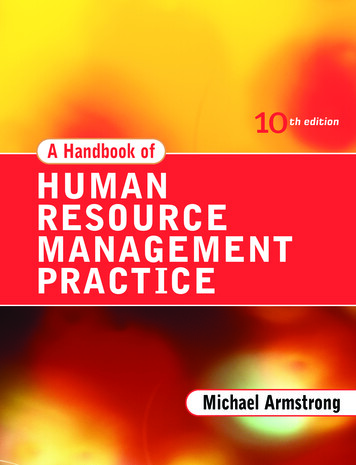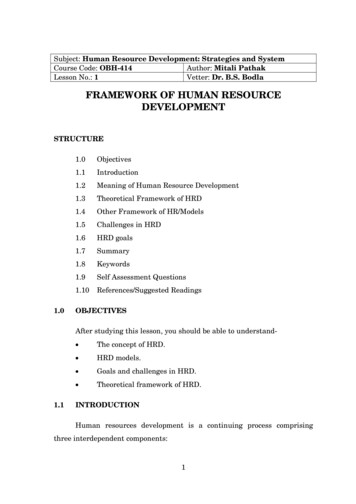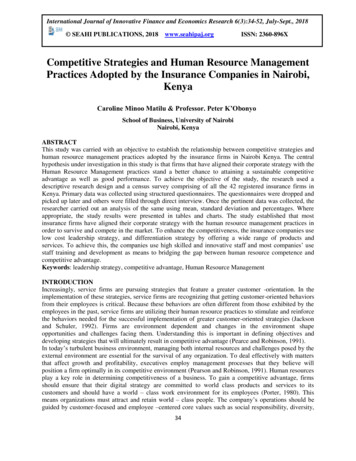
Transcription
International Journal of Innovative Finance and Economics Research 6(3):34-52, July-Sept., 2018 SEAHI PUBLICATIONS, 2018 www.seahipaj.orgISSN: 2360-896XCompetitive Strategies and Human Resource ManagementPractices Adopted by the Insurance Companies in Nairobi,KenyaCaroline Minoo Matilu & Professor. Peter K’ObonyoSchool of Business, University of NairobiNairobi, KenyaABSTRACTThis study was carried with an objective to establish the relationship between competitive strategies andhuman resource management practices adopted by the insurance firms in Nairobi Kenya. The centralhypothesis under investigation in this study is that firms that have aligned their corporate strategy with theHuman Resource Management practices stand a better chance to attaining a sustainable competitiveadvantage as well as good performance. To achieve the objective of the study, the research used adescriptive research design and a census survey comprising of all the 42 registered insurance firms inKenya. Primary data was collected using structured questionnaires. The questionnaires were dropped andpicked up later and others were filled through direct interview. Once the pertinent data was collected, theresearcher carried out an analysis of the same using mean, standard deviation and percentages. Whereappropriate, the study results were presented in tables and charts. The study established that mostinsurance firms have aligned their corporate strategy with the human resource management practices inorder to survive and compete in the market. To enhance the competitiveness, the insurance companies uselow cost leadership strategy, and differentiation strategy by offering a wide range of products andservices. To achieve this, the companies use high skilled and innovative staff and most companies‟ usestaff training and development as means to bridging the gap between human resource competence andcompetitive advantage.Keywords: leadership strategy, competitive advantage, Human Resource ManagementINTRODUCTIONIncreasingly, service firms are pursuing strategies that feature a greater customer -orientation. In theimplementation of these strategies, service firms are recognizing that getting customer-oriented behaviorsfrom their employees is critical. Because these behaviors are often different from those exhibited by theemployees in the past, service firms are utilizing their human resource practices to stimulate and reinforcethe behaviors needed for the successful implementation of greater customer-oriented strategies (Jacksonand Schuler, 1992). Firms are environment dependent and changes in the environment shapeopportunities and challenges facing them. Understanding this is important in defining objectives anddeveloping strategies that will ultimately result in competitive advantage (Pearce and Robinson, 1991).In today‟s turbulent business environment, managing both internal resources and challenges posed by theexternal environment are essential for the survival of any organization. To deal effectively with mattersthat affect growth and profitability, executives employ management processes that they believe willposition a firm optimally in its competitive environment (Pearson and Robinson, 1991). Human resourcesplay a key role in determining competitiveness of a business. To gain a competitive advantage, firmsshould ensure that their digital strategy are committed to world class products and services to itscustomers and should have a world – class work environment for its employees (Porter, 1980). Thismeans organizations must attract and retain world – class people. The company‟s operations should beguided by customer-focused and employee –centered core values such as social responsibility, diversity,34
Matilu & K’Obonyo . Int. J. Innovative Finance and Economics Res. 6(3):34-52, 2018quality and a passion for innovation, speed and adaptability. The changing global environment has led tomore competition, increased product choice, increased customer demand, lower prices, productinnovations and information technology (Johnson and Scholes, 2001). Kotler (2006) posits that,consumers have become more educated and informed more than ever before and they have the tools toverify companies‟ claim and seek out superior alternatives. Companies face intense competition fromdomestic and foreign brands which is resulting in rising promotion costs and shrinking profit margins.Due to changes in the market place, companies must cope with the dynamic environment in order tosurvive (Adcock et al, 2001).1.1.1 Human Resource Management (HRM) PracticesHuman resource management (HRM) is the strategic and coherent approach to the management of anorganization's most valued assets - the people working there who individually and collectively contributeto the achievement of the objectives of the business (Torrington & Hall 1987). Miller (1987) suggests thatHRM relates to: "those decisions and actions which concern the management of employees at all levels inthe business and which are related to the implementation of strategies directed towards creating andsustaining competitive advantage". HRM also refers to “people practices” which support business goals.These practices are embedded in the HR function such as, analysis and design of work, HR planning,Recruiting (attracting potential employees), Selection (choosing employees), Training and development(teaching employees how to perform their job and prepare them for the future) Compensation (rewardingemployees), Performance Management (evaluating their performance) and Employee Relations (creatinga positive work environment ). All these are geared strategically to maximize on company performance.The HRM practices support business goals and objectives. That is, effective HRM practices are strategic.Effective HRM enhances company performance by contributing to employees and customer satisfaction,innovation, productivity and development of a favorable reputation in the firm‟s community.1.1.2 Competitive StrategiesCompetitiveness refers to a company‟s ability to gain and maintain a reasonably market share in itsindustry. A strategy is defined as the “skillful employment of tactics in planning and management”(Webster‟s New American Dictionary). A strategy reflects companies‟ awareness of how and where itshould compete and for what purpose.Pearson and Robinson (2007) define competition as the state within a market setting where firms workand set strategies to gain advantage or greater success over each other. Competition denotes the existenceof firms that try to sell identical products or services to the same group of customers. A firm‟scompetitors may change over time in terms of their characteristics, strategies, and strategic focus due toenvironmental factors that affect the structure of the industry (Guiltinan and Paul, 1994).Competitive strategy consists of all those moves and approaches that a firm is taking to attract buyerswithstand competitive pressure and improve its market position (Thompson and Strickland, 2002).Competitive strategy, also known as a business strategy, is concerned with how a firm competes in agiven industry or market (Grant, 1998).1.1.3 Human Resource Management Practices and Competitive StrategiesAs stated earlier, competitiveness refers to a company‟s ability and performance to gain and maintainmarket share in its industry (Easterly and Levine, 2002). Human resource management practices,therefore, must help support the company‟s strategy and provide services with customer value. The valueof a product or service is determined by its quality and how closely the product fits customer needs.Competitiveness is related to company effectiveness which is determined by whether the companysatisfies the needs of stakeholders (Barney, 1991). Important stakeholders include: stockholders who wanta return on the investments; customers, who want a high-quality product or service; an employees, whodesire interesting work and reasonable compensation for their services and the community, which wantsthe company to contribute to activities and projects and minimal pollution of the environment. Companiesthat do not meet stake holder‟s needs are unlikely to have a competitive advantage over other firms in theindustry.35
Matilu & K’Obonyo . Int. J. Innovative Finance and Economics Res. 6(3):34-52, 2018Miles and Snow (1984) argued that HRM practices must be tailored to the demands of business strategy.They noted that successful firms display a consistent strategy supported by complimentary organizationstructures and management processes. Schuler and Jackson (1987) provided a detailed treatment of thethree competitive strategies (innovative, quality enhancement and cost reduction) and the required rolebehaviors. They argued that it is more useful to think about what is needed from an employee who workswith other employees in a social environment and the required employee behavior.1.1.4 Insurance Industry in KenyaInsurance industry in Kenya is one of the most risky businesses to venture in mainly because of thepotential risks that are involved and thus it is of interest to understand the survival tactics in such a riskybusiness. The main players in the Kenyan insurance industry are: insurance companies, reinsurancecompanies, insurance brokers, insurance agents and the risk managers. The statute regulating the industryis the insurance Act; laws of Kenya, chapter 487. There is also self regulation of insurance by theAssociation of Kenya Insurers (AKI). The professional body of the industry is the insurance institute ofKenya. In 2006 there was formed, the Insurance Regulatory Authority (IRA) to take up the role ofregulating, supervising, and developing the insurance industry players. Over the years, Kenya‟s insuranceindustry has continued to endear itself to the existing and potential customers through new products and asignificant improvement on its service delivery platforms, guaranteeing consumers of world class servicesdelivery.According to the AKI (2009), there were 42 licensed insurance companies with 20 companies writinggeneral insurance, 7 writing life insurance while 15 were composite. The insurance industry has beengrowing widely in Kenya and hence faced with stiff competition in the market. As a result, I have foundthis industry appropriate for my study to establish the competitive strategies used to survive and the roleof human resource management practices in attaining companies‟ sustainable competitive advantage1.2 Statement of the problemThe concern with the link between business strategy and human resource strategy today represents agrowing recognition of the importance of people in the achievement of organizational strategy. Thehuman resource management practices make the human resource strategy where, employees are seen askey in the implementation of the declared organizational strategy outcomes. The human resource functionshould ideally respond to organizational strategy by defining a strategy which meets organizational needs.For a company to be successful in attaining high performance, the link between its strategies should beholistic, with the people in the organization being recognized as the key to competitive advantage ratherthan just way of implementing organizational strategy. Human resource strategy therefore becomescritical and, as Baird et al (1983) argued, there can be no corporate strategy without human resourcestrategy. Boxall (1996) develops this idea in relation to resource based firm and argues that businessstrategy can usefully be interpreted as broader than a competitive strategy (or positioning in themarketplace). Butler (1989) identified the HR-driven model which places human resource strategy inprime position. He suggested that, if people are key to competitive advantage, then we need to as theimplementers of strategy to human resources as a driving force in the formulation of the strategy. Themodel acts as a shift from human resources.Despite the importance of the link between human resource management practices to corporatecompetitive strategies there appears to be no study that has addressed the relationship between these twoconcepts more so in Kenya. Given the developing nature of the Kenyan economy, one cannot assume thatfirms in the insurance sector have automatically made this alignment. If some of them have made thealignment and others have not, it would be important to demonstrate empirically there is a significantdifference between those companies that have achieved their alignment and those that have not done so.This will help bring out more clearly the importance of such alignment. This is what the proposed studysets out to do.Some studies have been done in Kenya on the area of competitive strategies. For example, Kimaru (2006)conducted a study on competitive strategies used by the agricultural chemical suppliers in Kenya. Hisobjectives were to determine the competitive strategies used by agricultural chemical suppliers in Kenya36
Matilu & K’Obonyo . Int. J. Innovative Finance and Economics Res. 6(3):34-52, 2018and also to determine the factors that influence the choice of such strategies. His findings were that lowcost strategy, differentiation strategy and the focus strategy as used by different companies, while thefactors affecting choice of strategy comprised of product, its quality, entrepreneurship and market orfocused learning capability. This study did not highlight the role of human resource managementpractices in the implementation of corporate strategy. Wacuka, (2007) conducted a study on competitivestrategies adopted by car dealers in Nairobi and she found that different companies used strategies such asquality services delivery to customers, competitive pricing, quality products and discounts. These studiesrevealed the existence of competitive strategies in the firms studied. However, they did not address thelink between the competitive strategies adopted and the role of human resource management practices inthe firms studied. Hence this study seeks to fill the knowledge gap on the relationship between humanresource management practices and the competitive strategies used by insurance firms in Kenya to gain acompetitive advantage in the market competition.Objective of the StudyTo establish the relationship between the Human Resource Management Practices and the competitivestrategies adopted by the insurance firms in Kenya.LITERATURE REVIEW2.1 Concept of StrategyJohnson and Scholes, (1993) defines strategy as the direction and scope of an organization over the longterm, which ideally matches resources to its changing environment and its particular markets so as tomeet stakeholders‟ expectations. This definition identifies three key components of strategy namelydefinition of scope and range of an organization‟s activities within the specific environment it faces, theneed of customers and markets matched against resource capability to determine long-term direction andlastly, the roles of stakeholders have on the strategy articulation because of their influence over thevalues, beliefs and principles which govern organizational behavior and business conduct.Chandler (1962) defines strategy as the determination of the basic long term goals and objectives of anenterprise, the adoption of action and the allocation of resources necessary for carrying out these goals.This means that strategy is about managing new opportunities. The strategy that is chosen should be onethat optimizes the resources available in order to achieve organizational goals and objectives. Accordingto (Thompson and Strickland, 1998) a strategy is a game plan that management has for positioning thecompany in its chosen market in order to compete successfully, please its customers and also achievegood business performance. Strategy is therefore crucial for organizations to obtain a viable matchbetween their external environment and their internal environment and capabilities and it also helps tocontinuously and actively adapt the organization to meet the demands of an ever-changing environment.Muriuki (2005) notes that strategy has become very critical and contributes to the organizational successand comes in handy as organizations continue to face turbulent environment.2.2 Competitive StrategiesCompetitive strategies consists of all the business moves and approaches that a firm undertakes to attractbuyers, withstand competitive pressure and improve its market position (Thomson and Strickland, 1993).It concerns what a firm is doing to in order to gain a sustainable competitive advantage. They are of theopinion that a company has competitive advantage whenever it has an edge over its rivals in securingcustomers and putting the company apart from its competitors. Competitive strategy is concerned withhow a firm competes in a given industry (Grant, 1998)Competitive strategy is defined as the bases on which a business unit might achieve competitiveadvantage in its market. Firm achieve this competitive advantage by providing their customers with whatthey want, or need, better or more effectively than competitors, and in ways in which their competitorsfind difficult to imitate (Johnson and Scholes, 2002). Porter (1980) refers to strategy as to how a companycompetes in a given industry and how a company can gain a competitive advantage through distinctiveways of competing.37
Matilu & K’Obonyo . Int. J. Innovative Finance and Economics Res. 6(3):34-52, 2018There are several generic competitive strategies that a firm can use in order to gain a sustainablecompetitive advantage according to Michael porter and will be used in this study because they deal withthe core issues that many organizations are concerned with, like cost efficiency and product/servicequality and are very crucial in the management of the insurance firms. Porter (1998) posits that a firm canuse three potential successful generic strategies to outperform other firms in an industry. They include:Low cost leadership strategy; Firms that chooses a low cost leadership strategy, focuses on gainingadvantages by reducing its economic costs below the cost of all its competitors (Barney, 1997).Competitive advantage through low prices might be sustained in a number of ways like; an organizationaccepting reduced margins because it can sell more volume than competitors, an organization beingprepared to sustain and win price war with competitors, an organization having cost advantage throughorganizationally specific capabilities that can drive down cost throughout the value chain, that is, beingthe low cost producer in the industry and exploiting all sources of cost advantage for, example byobtaining raw materials at lower prices than competitors, producing more efficiently, locating the firm inan area where labor cost is low among other ways. Low cost leadership can also be achieved throughfocusing on market segments where low price is particularly valued by customers (Johnson and Scholes,2008). Once Low cost is achieved, the position provides high margin which can be re-invested in newequipment and modern facilities in order to maintain cost leadership (Porter, 1998).Differentiation; this involves offering products or services that are perceived industry-wide as beingunique (Porter, 1998). Successful differentiation is based on a study of buyers‟ needs and behavior inorder to learn what they consider important and valuable that, understands well customer perception(Barney, 1997). The basis for competitive advantage is a product whose attribute differ significantly fromrivals products and creates difficulties of imitation. Profitable differentiation is achieved by either keepingthe cost of differentiation below the price premium that the differentiating features command, or byoffsetting the lower profit margins through more sales volumes (Bowman and Faulkner, 1997).Focus strategy; the focus strategy basis for competitive advantage is either lower costs than competitorsserving that market segment or an inability to offer niche members something different form competitors(Pearce and Robinson, 1997). Focusing is based on selecting a market niche where buyers havedistinctive preferences. The niche is defined by geographical uniqueness, specialized requirements inusing the product or by special attributes that appeal to members. Firms pursuing this strategy are willingto service isolate geographic areas, satisfy needs of customers with specific financing or servicingproblem or even to tailor the products to somewhat unique demands of the focused customers.2.3 Human Resource ManagementHuman resource management is the strategic and coherent approach to the management of anorganization's most valued assets - the people working there who individually and collectively contributeto the achievement of the objectives of the business. The terms "human resource management" and"human resources" (HR) have largely replaced the term "personnel management" as a description of theprocesses involved in managing people in organizationIn simple words, HRM means employing people, developing their capacities, utilizing, maintaining andcompensating their services in tune with the job and organizational requirement. The human resourcemanagement (HRM) plays a key role in determining the survival, effectiveness and competitiveness ofany company. HRM refers to the policies, practices, and systems that influence employees‟ behavior,attitude, and performance. (Gerhart and Wright, 2006). The HRM function has evolved over time and itbegan as purely administrative function but due to the market growth and competition globally, it is nowchanging to a strategic function. As a result, this has brought up the strategic human resourcemanagement (SHRM) which is defined as the linking of human resources with strategic goals andobjectives in order to improve business performance and develop organizational culture that fosterinnovation, flexibility and competitive advantage. SHRM means accepting and involving the HR functionas a strategic partner in the formulation and the implementation of the company‟s strategies through HRactivities such as recruiting, selecting, training and rewarding personnel (Boxall, 1992). The goal ofhuman resource management is to help an organization to meet strategic goals by attracting, and38
Matilu & K’Obonyo . Int. J. Innovative Finance and Economics Res. 6(3):34-52, 2018maintaining employees and also to manage them effectively. The key word here perhaps is "fit", i.e. aHRM approach seeks to ensure a fit between the management of an organization‟s employees, and theoverall strategic direction of the company (Miller, 1989).2.4 Human Resource Management PracticesHRM practices are a primary means for defining, communicating and rewarding desired role behaviors(Aldrich, 1979). Effective and efficient human resource management (HRM) practices are key to successin many industries. Organizations use their HRM practices to encourage the behaviors needed tosuccessfully carry out the employment roles. Given that the managerial role is different from the roles oflower-level employees in organizations, it is reasonable to expect that organizations would use somewhatdifferent human resource management practices for the two groups of employees (Jackson and Schuler,1992). Specifically, given the nature of the managerial role, it is probable that compared to hourlyemployees in service-based organizations; managers would be more likely to be influenced by thefollowing practices:Jobs with greater skill variety and responsibility, Performance appraisals that focus on results,Performance appraisals that focus on projects that takes a longer period of time, Compensation schemesbased on company-wide bonuses, Training that is provided for longer-term and broader skilldevelopment, and More training hours per year.HRM practices must be cost-effective while simultaneously assuring employee attraction and retention aswell as protection from legal liability. HRM and its practices are at the heart of organizational success andthe common HRM practices include:Analysis and design of work; Job analysis refers to the process of getting detailed information about jobs.This is because, to achieve high quality performance, or a firm to succeed, it must have detailedinformation about the requirements of jobs and attempt to place people in occupation that best suit theiraptitudes. Job analysis entails two parts namely: Job description and job specifications. A job descriptionis a list of the tasks, duties, and responsibilities that a job entails. A job specification on the other hand isa list of the knowledge, skills, abilities and other characteristics that an individual must have to performthe job. Job design on the other hand is the process of defining how work will be performed and the tasksthat will be required in a given job. Also is job redesign which refers to changing the tasks or the waywork is performed in an existing job (Gerhart and Wright, 2006).Human Resource Planning; Human resource planning is a process which consists of forecasting, goalsetting and program implementation and evaluation. Forecasting refers to the attempt to determine thesupply and demand for various types of human resources to predict areas within the organization wherethere will be future labor shortage or surpluses (Schuler, 1987). After forecasting, is goal setting andstrategic planning. The purpose of setting specific quantitative goals is to focus attention on the problemand provide a benchmark for determining the relative success of any programs aimed at redressing apending labor shortage or surplus. The goals should come directly from the analysis of labor supply anddemand and should include a specific figure for what should happen with the job category or skill areaand a specific timetable for when results should be achieved.Human Resource Recruitment; Recruitment involves attracting a pool of applicants upon which selectionprocedures will later be applied. Research suggests staffing effectiveness is both a function of the qualityand quantity of the applicant pool (Fisher, 1989). This is the practice carried on by the organization withthe primary purpose of identifying and attracting potential employees. Recruitment activities are designedto affect; the number of people who apply for vacancies, the type of people who apply for them and or thelikelihood that those applying for the vacancies will accept positions if offered. The goal of anorganizational recruitment program is to ensure that the organization has a number of reasonably qualifiedapplicants to choose from when a vacancy occurs (Gerhart, 2006). Recruitment can be external or internalwhere internal recruitment provides ample opportunity for advancement and promotion of the existingemployees.Selection and Placement; Personnel selection is the process by which companies decide who will or willnot be allowed into organizations. There are five generic standards to be met in any selection process39
Matilu & K’Obonyo . Int. J. Innovative Finance and Economics Res. 6(3):34-52, 2018namely: reliability, validity, generalizability, utility and legality. There are several methods used in theselection process like, interviews, physical ability tests, cognitive ability tests, work sample tests, amongothers (Robinson, 1981).Training and Development; Training refers to a planned effort by a company to facilitate employees‟learning of job- related competencies (Gerhart, 2006). These competencies include knowledge, skills orbehaviors that are critical for successful job performance. (Mathias and Jackson, 2000) define training asa learning process whereby people acquire capabilities to aid in achievement of organizational goals. Thegoal of training is to provide employees with knowledge, skills and behaviors emphasized in the trainingprogram and apply them to their day –to –day activities. Recently, training has been acknowledged tooffer a competitive advantage and thus training should include more than just basic skill development to abroader focus of creating and sharing knowledge (Wright et al 2006). A key characteristic of trainingactivities that contribute to competitiveness is that they are designed according to the instructional designprocess which has several steps mainly; Needs assessment by analyzing the organization, the individualand the task, ensuring employees‟ readiness for training, creating a learning environment, selectingtraining methods and evaluating the training programs in terms of training outcomes and cost benefitanalysis.On the other hand, employee development involves learning that goes beyond today‟s job; it has a morelong term focus (Mathias and Jackson, 2000). It prepares employees to keep pace with the organization asthe company changes and grows. (Wright and Gerhart, 2006) defines development to be the formaleducation, job experiences, relationships, and assessment of personality and abilities that help employeesprepare for the future. Its learning is not necessarily related to the current job. It is the acquisition ofknowledge, skills, and behavior that improves an employee‟s ability to meet changes in job requirementsand in client and customer demands.Performance Management; Companies that seek competitive advantage through employees must be ableto manage the behavior and results of all employees. (Wright and Gerhart, 2006) defines performancemanagement as the process through which managers ensure that employees‟ activities and output arecongruent with the organization‟s goals. They further explain that, performance management has threeparts namely: defining performance rooted from job analysis, measuring performance throughperformance appraisal, and feedback performance information to employees. The purposes ofperformance management system in an organization are of three kinds: strategic, administrative, andde
marketplace). Butler (1989) identified the HR-driven model which places human resource strategy in prime position. He suggested that, if people are key to competitive advantage, then we need to as the implementers of strategy to human resources as a driving force in the formulation of the strategy. The model acts as a shift from human resources.


![05[2] Strategy competitors, competitive rivalry .](/img/2/052-strategy-competitors-competitive-rivalry-competitive-behavior-and-competitive-dynamics.jpg)

